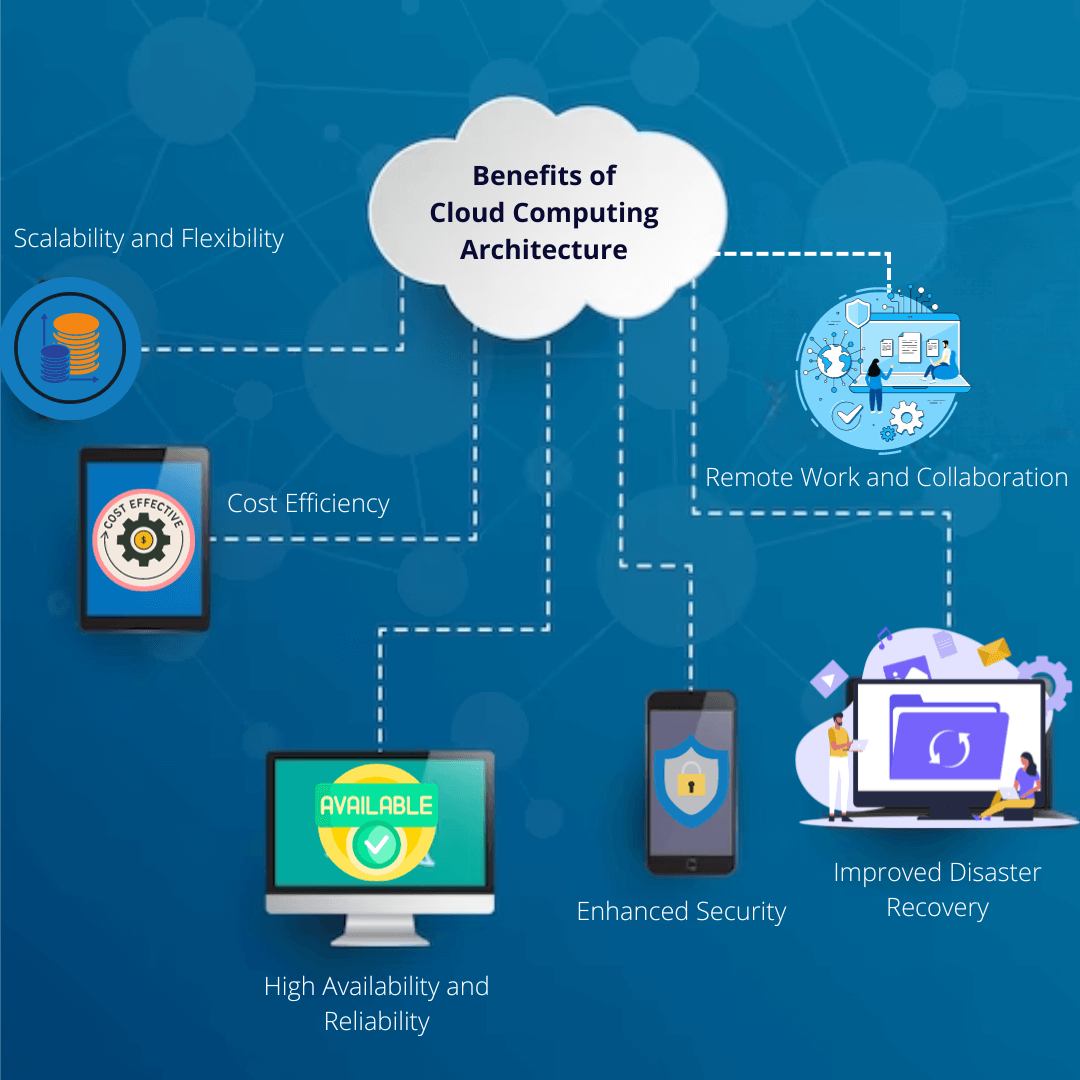Cloud Architecture: Unlocking the Potential of Modern Software Systems

Introduction
In today’s rapidly evolving digital landscape, cloud computing has emerged as a transformative force, revolutionizing how organizations operate and deliver services. With its ability to provide on-demand virtualized resources, cloud architecture offers unparalleled flexibility, scalability, and cost efficiency.
It is a key element that shapes and orchestrates the components and technologies required for cloud computing. This comprehensive guide will delve into the intricate world of cloud architecture, exploring its definition, components, benefits, and best practices.
Understanding Cloud Architecture
Cloud architecture is the blueprint that defines the layout and connectivity of various cloud technology components, such as hardware, virtual resources, software capabilities, and virtual network systems.
It is a guiding framework that strategically combines resources to build a cloud environment tailored to meet specific business needs.
Consider it the foundation upon which cloud-based applications and workloads are built and deployed.
Cloud architecture is a fusion of two architectural paradigms – Service-Oriented Architecture (SOA) and Event-Driven Architecture (EDA). It encompasses a range of components, including client infrastructure, applications, services, runtime cloud, storage, infrastructure, management, and security.
Each component plays a vital role in enabling seamless operation and delivery of cloud computing services.
Also Read: CQRS and Event Sourcing for Software Architecture.

Frontend: Empowering User Experiences
The front end of cloud architecture represents the client-facing side of the cloud computing system. It comprises the user interfaces and applications that allow clients to access and interact with cloud computing services and resources.
The frontend acts as a gateway, providing a graphical user interface (GUI) that enables users to interact with the cloud seamlessly.
One crucial frontend component is the client infrastructure, encompassing the applications and user interfaces required to access the cloud platform.
It provides a user-friendly interface that empowers clients to leverage the full potential of cloud computing services. Whether accessing cloud-based applications through a web browser or utilizing specialized client software, the front end ensures a smooth and intuitive user experience.
Backend: Powering the Cloud
The backend of cloud architecture solutions refers to the cloud infrastructure itself, which cloud service providers utilize to deliver services to clients.
It encompasses a wide range of resources, management mechanisms, and security measures that enable cloud computing environments’ seamless operation and scalability.
One key component of the backend is the application, which refers to the software or platform that clients access to fulfill their specific requirements.
The application is the backbone of the cloud architecture, enabling the execution of tasks and the delivery of services. The service component is also crucial in managing and orchestrating various tasks and resources within the cloud environment.
It offers various services, including storage, application development environments, and web applications.
The runtime cloud provides the execution environment for services, acting as an operating system that handles the execution of service tasks and management.
It utilizes virtualization technology, such as hypervisors, to create a virtualized environment that hosts applications, servers, storage, and networking resources.
Storage is another essential backend component, providing flexible and scalable storage services for data and applications. Cloud storage options vary among providers, offering various solutions, including Amazon S3, Oracle Cloud Storage, and Microsoft Azure Storage.
These storage services are designed to handle vast data and ensure reliable and secure data management.
Infrastructure forms the backbone of the cloud architecture, encompassing both hardware and software components. It includes servers, storage devices, network devices, and virtualization software, which collectively power the cloud services.
The management component oversees and coordinates various aspects of the cloud environment, including application, task, security, and data storage management. It ensures seamless coordination and efficient allocation of cloud resources.
Security is critical to cloud architecture, providing robust measures to protect cloud resources, systems, files, and infrastructure. Cloud service providers implement various security mechanisms, such as virtual firewalls, data encryption, and access controls, to safeguard client data and ensure a secure cloud computing environment.
The internet acts as the bridge between the front and back end, facilitating communication and data transfer between these components. It ensures seamless connectivity and enables clients to access cloud services from anywhere in the world.
Benefits of Cloud Computing Architecture
Cloud computing architecture offers many benefits that empower organizations to achieve their goals efficiently and effectively. Let’s explore some of the key advantages of adopting cloud architecture:

Scalability and Flexibility
Cloud architecture provides organizations with unparalleled scalability and flexibility. By allowing businesses to scale computing resources up or down based on demand, they can easily accommodate fluctuating workloads and scale their operations accordingly.
This scalability ensures optimal resource utilization, eliminates the need for excessive hardware investments, and enables organizations to respond swiftly to changing market dynamics.
Cost Efficiency
One of the most significant advantages of cloud computing architecture is its cost efficiency. By leveraging the pay-as-you-go model, businesses only pay for the computing resources they consume, eliminating the need for upfront hardware investments and reducing operational costs.
Additionally, cloud architecture allows organizations to optimize resource allocation, ensuring that resources are utilized efficiently, further driving down costs.
High Availability and Reliability
Cloud architecture offers robust mechanisms that ensure the high availability and reliability of cloud services. With redundant infrastructure and failover systems, organizations can minimize downtime and ensure uninterrupted access to critical applications and data.
Cloud providers employ advanced monitoring and management tools to proactively identify and address potential issues, ensuring reliable service delivery.
Enhanced Security
Security is a paramount concern in today’s digital landscape, and cloud architecture provides robust security measures to protect sensitive data and ensure regulatory compliance. Cloud service providers employ advanced encryption techniques, access controls, and security protocols to safeguard client data from potential threats.
Additionally, cloud architecture enables organizations to leverage centralized security management tools, ensuring consistent security across the entire cloud environment.
Improved Disaster Recovery
Cloud architecture offers enhanced disaster recovery capabilities, enabling organizations to quickly recover from unforeseen events like data breaches or natural disasters.
With built-in backup and replication mechanisms, data can be securely stored and replicated across geographically diverse locations, ensuring data resilience and minimizing the risk of data loss.
Organizations can quickly restore operations and minimize downtime in a disaster, ensuring business continuity.
Remote Work and Collaboration
Cloud architecture enables remote work and collaboration, allowing teams to access and collaborate on projects from anywhere in the world. By leveraging cloud-based applications and services, organizations can foster a remote work culture, enabling increased productivity, flexibility, and collaboration among team members.
Cloud architecture empowers organizations to build virtual workspaces, enabling seamless communication and collaboration, irrespective of physical location.
Also Read: The Impact of Cloud Computing in Healthcare.

Cloud Architecture Best Practices
Organizations should adhere to best practices that ensure optimal performance and efficiency to fully leverage the advantages of cloud computing architecture. Here are some key best practices to consider:
1. Comprehensive Assessment
Before embarking on cloud architecture design, conduct a comprehensive assessment of your organization’s current and future computing needs. Understand your requirements, workloads, scalability needs, and security considerations to choose the appropriate cloud deployment and service models.
2. Design for Resilience and Recovery
Build resiliency and recovery capabilities into your cloud architecture to ensure continuity in the face of disruptions. Implement redundancy, backup, and replication mechanisms to safeguard data and enable quick recovery during a disaster. Regularly test and update your disaster recovery plans to maintain their effectiveness.
3. Decoupling Applications
Decouple applications into a collection of services to increase scalability, performance, and cost efficiency. Adopt a microservices architecture that allows you to independently scale and manage individual components of your application, enabling agility and flexibility.
4. Optimize Data Storage
Optimize data storage costs, availability, performance, and scalability by employing vertical, horizontal, and functional data partitioning techniques. Leverage cloud storage services that offer flexible and scalable options, such as Amazon S3, Oracle Cloud Storage, and Microsoft Azure Storage.
5. Embrace Automation
Leverage automation to streamline and optimize your cloud architecture. Automate resource provisioning, deployment, and management processes to ensure efficient resource utilization and minimize manual intervention. Implement robust monitoring and alerting systems to identify and address potential issues proactively.
6. Implement Robust Security Measures
Security should be a top priority in cloud architecture design. Implement a multi-layered security approach that includes encryption, access controls, identity and access management, and regular security audits. Regularly update and patch your systems to protect against emerging threats.
7. Foster Cloud Visibility
Leverage cloud monitoring tools to gain comprehensive visibility into your cloud environment. Implement monitoring and logging mechanisms that provide insights into resource utilization, performance, and security. Use these insights to optimize resource allocation, detect anomalies, and ensure seamless operations.
8. Establish Governance and Compliance
Maintain consistent governance and compliance within your cloud environment. Establish policies, protocols, and accountability mechanisms to ensure regulatory compliance and adherence to industry standards. Regularly audit your cloud environment to identify and address any compliance gaps.
9. Cost Optimization
Regularly review and optimize your cloud costs to ensure efficient resource utilization and cost control. Leverage cost management tools provided by cloud service providers to analyze resource usage, identify cost-saving opportunities, and implement cost optimization strategies.
10. Continuous Learning and Improvement
Cloud architecture is an ever-evolving field, and organizations should foster a culture of continuous learning and improvement. Stay updated with the latest trends and technologies in cloud computing, explore new services and features offered by cloud providers, and continuously evaluate and refine your cloud architecture to meet evolving business needs.
Conclusion
Cloud architecture is the bedrock of modern software systems, enabling organizations to harness the full potential of cloud computing. By strategically designing and implementing cloud architecture, businesses can unlock the benefits of scalability, flexibility, cost efficiency, and security.
Adhering to best practices and continuously optimizing cloud architecture ensures optimal performance, resilience, and agility in a rapidly evolving digital landscape. Embrace cloud architecture as a catalyst for digital transformation and propel your organization towards innovation and success in the cloud era.
Tags: Cloud, cloud architecture, Cloud Computing
![Blog-[x]cube LABS](https://d6fiz9tmzg8gn.cloudfront.net/wp-content/uploads/2016/06/blog_banner.jpg)






